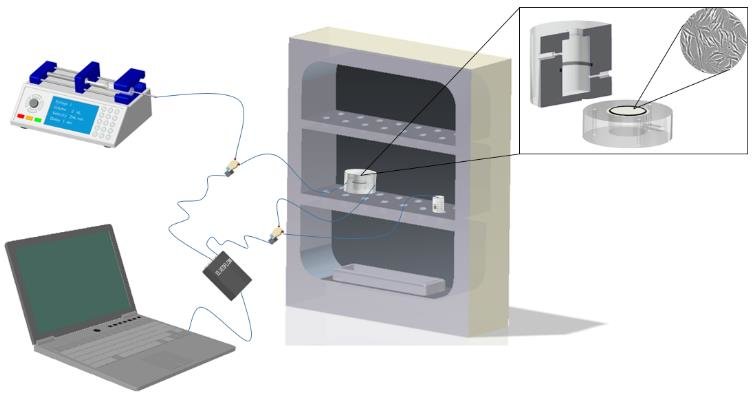
Figure 1. Complete scheme of the perfusion system with the syringe pump, the PC and the pressure sensor with the reader.The camera is located inside the incubator. In the right-hand side of the figure, the inner structure of the camera can be seen. (A) Represents the way the liquid follows, entering from the upper part to exit from the bottommost hole. (B) The lowest piece of the camera, which contains the PCL mesh with the HTMC
Complete scheme of the perfusion system with the syringe pump, the PC and the pressure sensor with the reader. The camera is located inside the incubator. In the right-hand side of the figure, the inner structure of the camera can be seen.
- (A) Represents the way the liquid follows, entering from the upper part to exit from the bottommost hole.
- (B) The lowest piece of the camera, which contains the PCL mesh with the HTMC
The constructed circuit is equipped with a programmable syringe pump (Chemyx® Fusion 100, Stafford, USA) and two pressure sensors (Elveflow®, Paris, France) as shown in Figure 1. The system follows a simple working principle. A control program designed using the graphical programming environment LabView (National Instruments® Austin, Texas) is used to monitor and ensure the correct functioning of the apparatus. The interface portrays the real time values of the pressure sensors and generates a scenario-representative graph. The nanofibrous scaffolds were secured inside the camera. This system allows the control of the flow and the measurement of the transmembrane pressure, enabling the study of the permeability characteristics of our HTM model. In our experiment, we first introduced the different electropsun meshes inside the camera and perfused them with a flow rate of 20 µL/min for 20 min. On forward steps, HTMC seeded on PCL scaffolds will be introduced in the camera with the same flow rate to observe pressure differences. For future lines, the effect of pressure on these cells will be studied and different drugs will be perfused to observe the cell´s response.
Published November 2020
Authors: Maria Bikuña Universidad de Navarra, E Carnero González, L Extramiana Esquisabel, Javier Aldazabal Tecnun – University of Navarra
